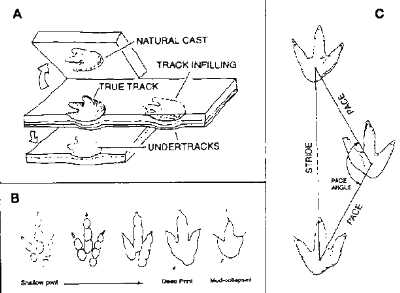
The fossilization of dinosaur footprints and trackways can help us learn about many biological traits and aspects. They tell a story of how the animal interacted with the environment in which they lived.
Footprints and trackways help us interpret:
ð physical aspects regarding the
dinosaurs gait, speed and stance
ð did they move in packs, herds or
were they solitary creatures
ð migrating patterns and correlation to the substrate
 |
The different forms of dinosaur tracks found (Diagram A), Shape of track dependent on hardness of the substrate (Diagram B), Demonstration of where to take the stride length and pace angle from so that one can deduce the gait of the animal (Diagram C) |
Contrary to the preservation of most fossils, the fossilization
of dinosaurs tracks must be done under slow and tranquil conditions. The
tracks of dinosaurs are normally found as either impressions in the substrate
or as casts from the overlying substrate. An impression is made by
the animal crossing the substrate and leaving a mould within the sediment,
and is referred to as negative relief. A cast is made by overlying
sediment filling the impression or mould and forming a replica of the footprint,
and is referred to as positive relief. After a track is formed, it
must first dry out and harden, if this is accomplished then the print will
not be disturbed by the weight of eventually deposited sediment.
After hardening the tracks are slowly buried so as to not disturb their
configuration. If the overlying sediment is different then the host
sediment the separation of the layers by erosion will not disturb the impression.
Before erosion can take place to reveal the imprint,
the sedimentary layer hosting the impression must turn to stone otherwise
the track is lost. If the lithified track is left exposed to the
elements it too will eventually erode away or become distorted. If
the dinosaur was large, it could also distort the sediment beyond the surface
and these are known as under tracks. Under tracks are more easily
preserved since they are within the subsurface, any erosion at the time
would not disturb them unless it is extensive.